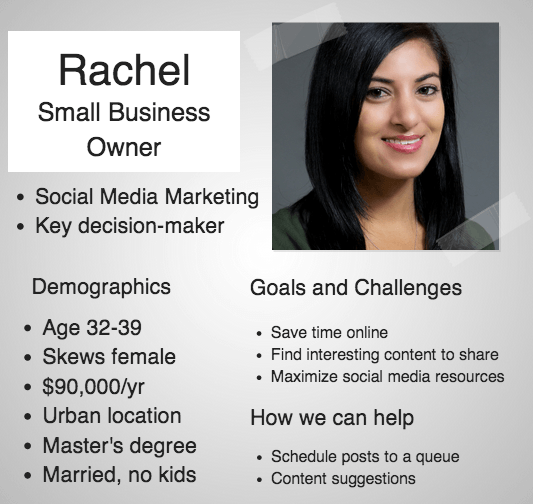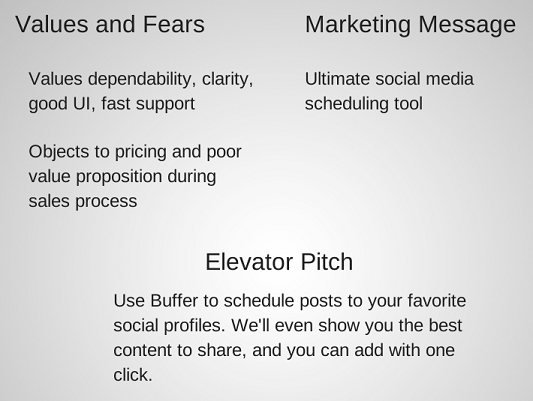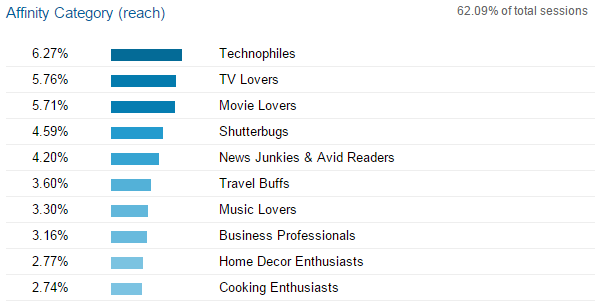-
 9 min. read
9 min. read
-
 Trevin Shirey
Trevin Shirey VP of Marketing
VP of Marketing
- Trevin serves as the VP of Marketing at WebFX. He has worked on over 450 marketing campaigns and has been building websites for over 25 years. His work has been featured by Search Engine Land, USA Today, Fast Company and Inc. Read his review of working with WebFX for the last 15 years.
If you keep up with marketing blogs or publications of any kind, you’re probably familiar with the idea of “marketing personas.”
Both traditional and Internet marketers talk about them as an absolute necessity, but can fictional people really help your strategy? We think so.
At WebFX, we have detailed personas (complete with stock photo faces) that we keep in mind when creating any new site content or marketing materials. And by writing to specific “people,” we’re able to make our copy feel personal, instead of generic and boring.
If you’re still not convinced (or just not sure how to get started), read on.
We’ll take a look at why you should have marketing personas, and how you can create accurate ones that will help you make sure that all of your marketing efforts are written with your ideal customers in mind.
Why do you need marketing personas?
First, let’s start by defining what marketing personas are: Fictional, but data-based characters that represent different parts of your target audience.
Together, your personas should form a fairly comprehensive look at everyone you are trying to reach with your marketing.
If your personas are detailed and you think of them as real people, you’ll have an easier time addressing their individual needs and values.
And if you take the time to create accurate personas, that means you’ll really be addressing the needs and values of your target audience. Take, for example, this sample persona that Buffer shared on their blog:
In addition to basic information, they also include her values, fears, and the kind of marketing message she responds well to:
With all of this information, it’s easy to imagine that Rachel is a real person – and to write content that will appeal to her.
And considering that she’s really a composite of many real individuals, there’s a good chance that copy written with her in mind will resound with quite a few of them.
How can you create marketing personas?
Now that you have an idea of why personas are useful, you’re (hopefully) ready to start forming your own. But while it might be fun to just make up a bunch of random people – especially if you’re the type that had imaginary friends as a child – that doesn’t make for a sound marketing strategy.
Here are a few important elements for creating accurate personas:
Demographics
The first step to creating your personas is looking at some basic site demographic information like age, gender, and location.
All of this information can be easily found in the “Audience” tab of your Google Analytics account.
This information is extremely general, but it should help you get a general idea of what your personas will ultimately look like.
Should they all be male or all be female? Or half and half? Should they be young, old, or a mix of both?
When looking at this information, it’s important to consider whether or not it is an accurate representation of your customers, since site visits don’t necessarily translate into leads or purchases.
Assessment of current customers
One of the best ways to get an accurate idea of what your potential customers are like is by looking at your current ones.
Because of this, data from lead submissions, customer surveys, and LinkedIn profiles can be extremely useful.
If you have contact forms on your site, consider adding fields beyond, “name,” and, “email.”
While we recommend keeping your forms as simple as possible, if yours are already short, you may want to add a field or two, like, “company,” or, “job title.”
This will provide you with an easy way to look at the industries and positions of your potential customers. You may also consider sending out optional customer surveys to longtime clients. You can use surveys to gauge customer satisfaction, and in this case, you’ll also want to identify why they chose your company over your competitors in the first place.
This will give you insight into your customers’ thought processes – and should also carry over into the creation of your personas.
In addition to asking for information, you can also find it for yourself on LinkedIn.
Considering that it is a platform designed specifically for networking and professional purposes, there’s a good chance that your clients have profiles complete with their employers, job titles, education, and skills.
Career information
Once you’ve established a few basic outlines, it’s time to start building them out. Although this next step will vary depending on whether your company is B2B or B2C, one of the most important steps in our own process was determining career information for our personas.
Where do these individuals work? What is their position in the company?
What are they responsible for? If you’re a B2B company, the answers to these questions play a huge role in how you should approach your marketing.
For example, the language you use to appeal to a small business owner probably isn’t nearly as effective with a lower-level employee at a large corporation – so if you want to reach them both, you’ll need to market to them individually.
Values
Next, you’ll need to determine what is important to each of these people.
This can be a bit of a challenge, but can also be included in customer surveys. Your potential clients are likely similar to your current ones, so by asking them what they value about your product, or about business purchases in general, you can get a pretty good idea of what your personas find important.
Another way to determine your audience’s values is by looking for reviews of your company or services.
It’s typically a good idea to keep tabs on what is being said about you online anyway, and if there’s a particular thought that your customers continue to bring up, it’s clear that they generally find it important.
Goals
Along the same lines, your audience’s goals should play a role in the creation of these individual personas. What do they hope to accomplish, and how can you help?
Think about why your customers use your product, and why potential customers should. Then, assign those goals to relevant personas.
“Human” details
Once you have basic information, it’s time to humanize your data-based figures.
Give them names, backstories, and families. Find a few stock photos to put faces to the names.
Maybe even look at the affinity categories section of your site’s analytics and give them some hobbies:
This is the part you can have fun with – and it’ll make using them a lot more interesting.
Assessment
If you work directly with customers, this process will be much easier. If not, you may want to consider consulting your sales team after you’ve drafted your ideas.
After all, they’re the ones who come face to face with the real versions of your personas, and they’ll be able to give you feedback on whether your ideas are accurate.
How can you use your marketing personas?
Now that you have your personas, it’s time to starting using them. So how can these composite “people” assist you with your marketing?
Make them a part of your strategy
Given the constantly changing nature of Internet marketing, you should ideally evaluate and revise your strategy every few months. Whether that means meeting with an entire marketing team or just getting your own thoughts together, your personas should certainly be a part of the process.
- What channels are the most important to these people?
- Are they on social media? Which platforms?
- Do they respond well to certain types of content?
- Do the values and benefits associated with your services appeal to them?
Answer these questions for each individual persona, and adjust your strategy accordingly.
Adjust your sales pitches
The language you use to approach all potential customers or clients should not be the same. Your business likely serves more than one type of person, and your sales pitches should reflect that.
Set aside some time to write out a “pitch” you think would appeal to each individual persona. Emphasize the features that they would be most interested in, address any concerns they might have, and use language specific to their position in the buying process.
Once you have a few pitches worked out, think about where you could use them in your marketing.
Is one of your personas active on a certain social platform? Use that pitch in a paid ad.
Does one of your personas tend to go to a certain page on your site? Use the language from the pitch in the copy (or maybe even create a personalized landing page).
Write blog posts and articles with them in mind
Assuming that content is part of your marketing strategy, you should always aim to figure out which of your personas you are speaking to before beginning to write.
Which ones read your blog?
Your articles? If you write as if you are speaking to an individual person (or maybe two people), you’ll be able to cater to their interests. You’ll also be able to adapt your tone and style accordingly.
WebFX is a Partner in Driving Results
Hear from HydroWorx, who saw a 131% increase in organic forms by partnering with WebFX
Time to get started!
Now that you have an idea of how to create marketing personas, it’s time to start doing some research.
Creating accurate and useful representations of your target audience will certainly require some time and effort, but from our own experience, they’re worth trying out.
-
 Trevin serves as the VP of Marketing at WebFX. He has worked on over 450 marketing campaigns and has been building websites for over 25 years. His work has been featured by Search Engine Land, USA Today, Fast Company and Inc. Read his review of working with WebFX for the last 15 years.
Trevin serves as the VP of Marketing at WebFX. He has worked on over 450 marketing campaigns and has been building websites for over 25 years. His work has been featured by Search Engine Land, USA Today, Fast Company and Inc. Read his review of working with WebFX for the last 15 years. -

WebFX is a full-service marketing agency with 1,100+ client reviews and a 4.9-star rating on Clutch! Find out how our expert team and revenue-accelerating tech can drive results for you! Learn more
Try our free Marketing Calculator
Craft a tailored online marketing strategy! Utilize our free Internet marketing calculator for a custom plan based on your location, reach, timeframe, and budget.
Plan Your Marketing Budget

Looking for More?
Get expert ideas, industry updates, case studies, and more straight to your inbox to help you level up and get ahead.
"*" indicates required fields

Proven Marketing Strategies
Try our free Marketing Calculator
Craft a tailored online marketing strategy! Utilize our free Internet marketing calculator for a custom plan based on your location, reach, timeframe, and budget.
Plan Your Marketing Budget
What to read next











